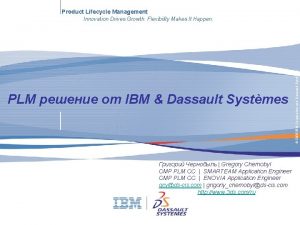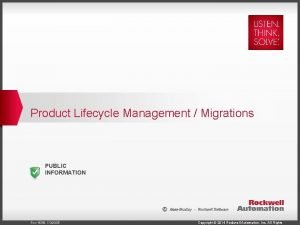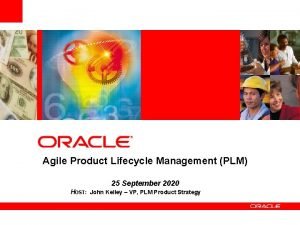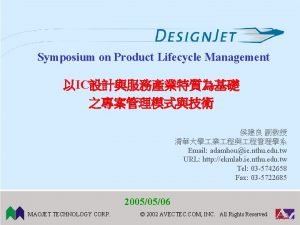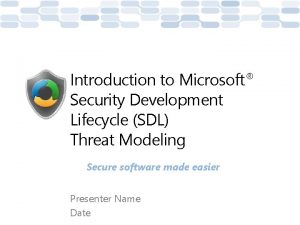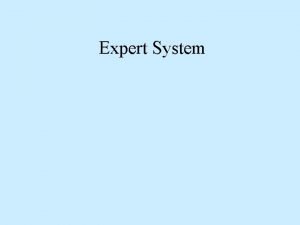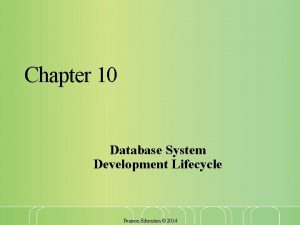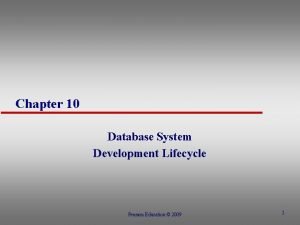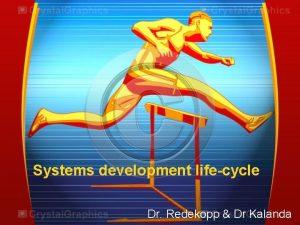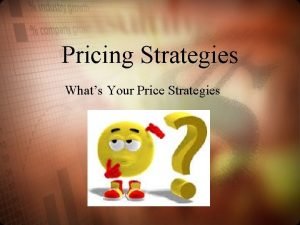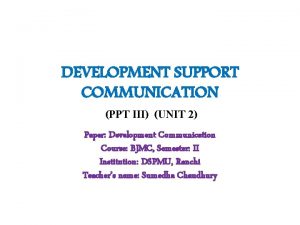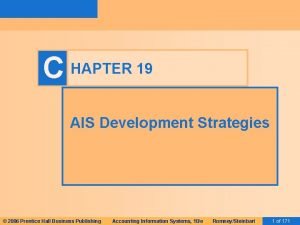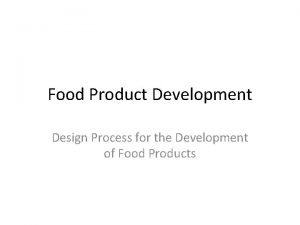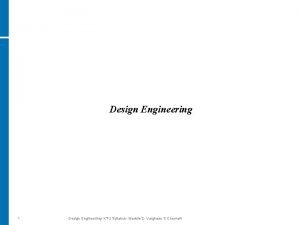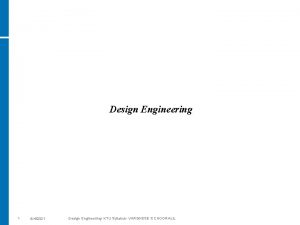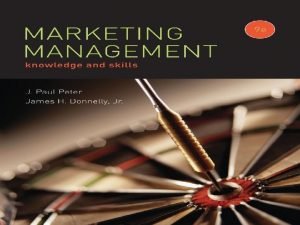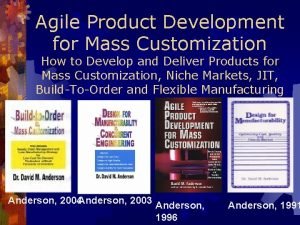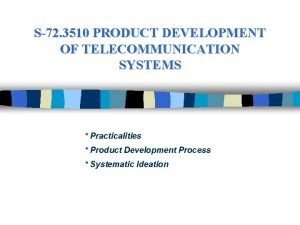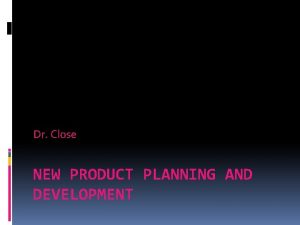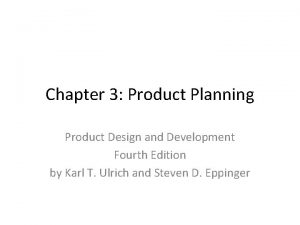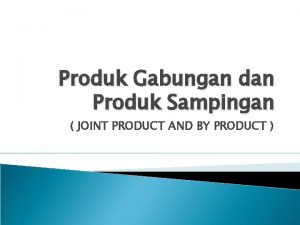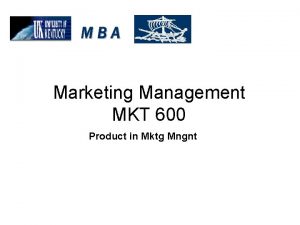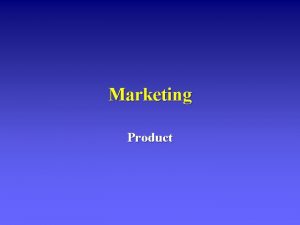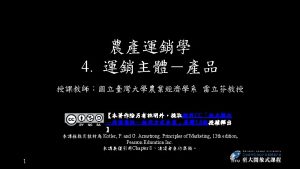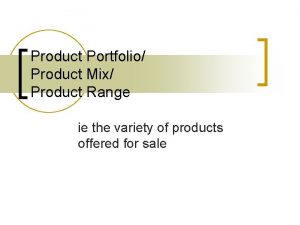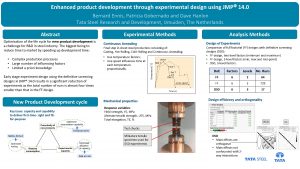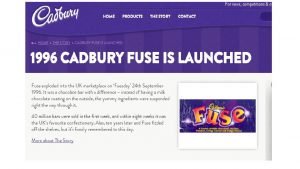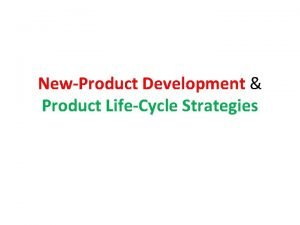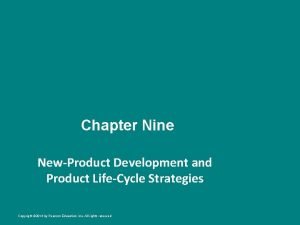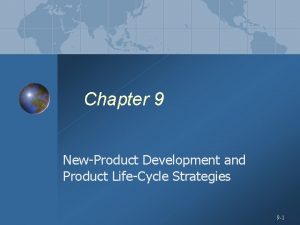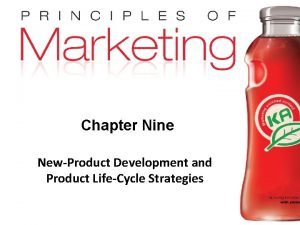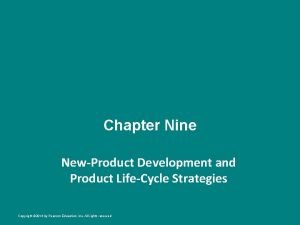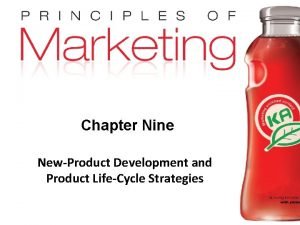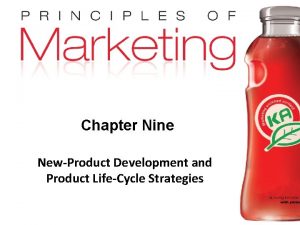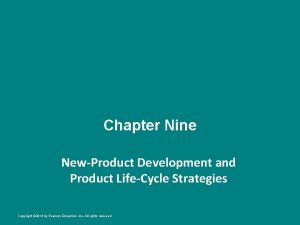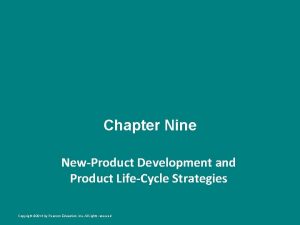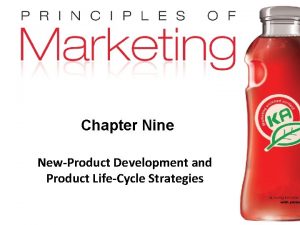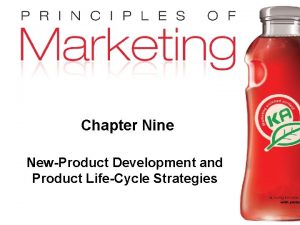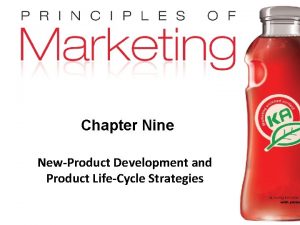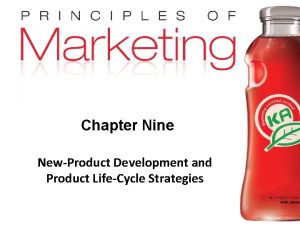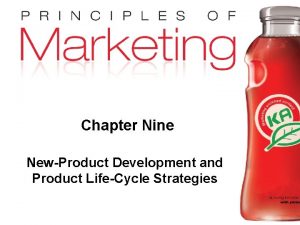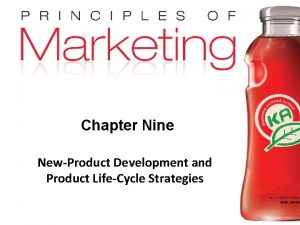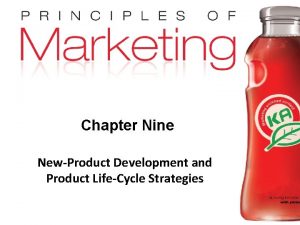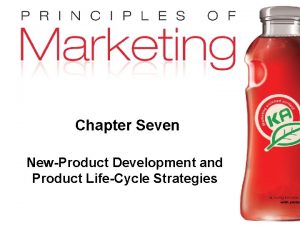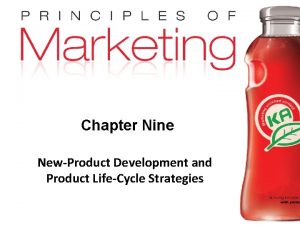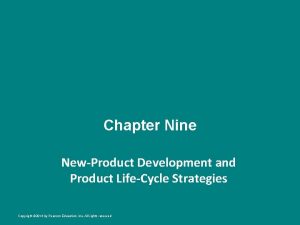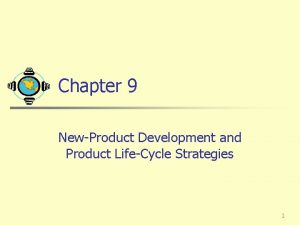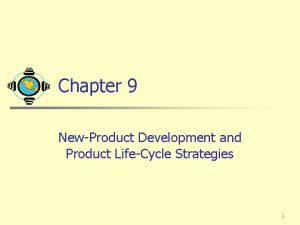6 c NewProduct Development and Product LifeCycle Strategies














































- Slides: 46

6 c New-Product Development and Product Life-Cycle Strategies Professor Takada

ROAD MAP: Previewing the Concepts • How companies find and develop new- product ideas. • Steps in the new-product development process. • Stages of the product life cycle. • How marketing strategies change during the product’s life cycle. Professor Takada 6 c-2

ROAD MAP • How companies find and develop newproduct ideas. • List and define the steps in the newproduct development process. • Describe the stages of the product life cycle. • Describe how marketing strategies change during the product’s life cycle. Professor Takada 6 c-3

3 M Emphasizes New Product Development Professor Takada 6 c-4

Categories of New Products New-to-the-world New product lines Additions Improvements Repositionings Cost reductions Professor Takada 6 c-5

Innovations Professor Takada 6 c-6

Factors That Limit New Product Development • Shortage of ideas • Fragmented markets • Social and governmental constraints • Cost of development • Capital shortages • Faster required development time • Shorter product life cycles Professor Takada 6 c-7

Finding One Successful New Product Professor Takada 6 c-8

New-Product Failures • Only 10% of new products are still on the market and profitable after 3 years. • Failure rate for industrial products is as high as 30%. • Why? – Overestimation of market size – Design problems – Incorrectly positioned, priced, or advertised – Pushed despite poor marketing research findings – Development costs – Competition Professor Takada 6 c-9

Venture Team Cross-functional group charged with developing a specific product or business; intrapreneurs are relieved of other duties and provided a budget and time frame. Professor Takada 6 c-10

Criteria for Staffing Venture Teams • Desired team leadership style • Desired level of leader • • expertise Team member skills and expertise Level of interest in concept Potential for personal reward Diversity of team members Professor Takada 6 c-11

New-Product Development Strategy Strategies for Obtaining New-Product Ideas Acquisition of: New Products: Companies Original Products Patents Improvements Licenses Modifications Professor Takada 6 c-12

ROAD MAP • Explain how companies find and develop new-product ideas. • Steps in the new-product development process. • Describe the stages of the product life cycle. • Describe how marketing strategies change during the product’s life cycle. Professor Takada 6 c-13

Major Stages in New-Product Development Professor Takada 6 c-14

Idea Generation Company Employees Customers Competitors Distributors Suppliers Professor Takada 6 c-15

Idea Generation: Creativity Techniques • Attribute listing • Forced relationships • Morphological analysis • Reverse assumption • • analysis New contexts Mind mapping Professor Takada 6 c-16

Lateral Mapping • Gas stations + food • Cafeteria + Internet • Cereal + snacking • Candy + toy • Audio + portable Professor Takada 6 c-17

Idea Screening • Process to spot good ideas and drop poor ones. • Develop system to estimate: market size, product price, development time and costs, manufacturing costs, and rate of return. • Evaluate these findings against set of company criteria for new products. Professor Takada 6 c-18

Product-Idea Rating Device Professor Takada 6 c-19

Concepts in Concept Development • Product idea • Product concept • Category concept • Brand concept • Concept testing Professor Takada 6 c-20

Concept Testing • Communicability and believability • Need level • Gap level • Perceived value • Purchase intention • User targets, purchase occasions, purchasing frequency Professor Takada 6 c-21

Utility Functions Based on Conjoint Analysis Professor Takada 6 c-22

Airlines Use Conjoint Analysis Professor Takada 6 c-23

Concept Development and Testing • Product Idea – idea for a possible product that the company can see itself offering. • Product Concept – detailed version of the idea stated in meaningful consumer terms. • Product Image – the way consumers perceive an actual or potential product. Professor Takada 6 c-24

Marketing Strategy Development Part One Describes: The Target Market Planned Product Positioning Sales, Market Share, & Profit Goals Part Two Outlines the First-Year’s: Product’s Planned Price Distribution Marketing Budget Part Three Describes Long-Run: Sales & Profit Goals Marketing Mix Strategy Professor Takada 6 c-25

Business Analysis • Involves a review of the sales, costs, and profit projections to assess fit with company objectives. • If yes, move to the product development phase. Professor Takada 6 c-26

Product Development • Develop concept into • • • physical product Calls for large jump in investment Prototypes are made Prototype must have correct physical features and convey psychological characteristics Professor Takada 6 c-27

Test Marketing • Product and program introduced in more realistic market setting. • Not needed for all products. • Can be expensive and time consuming, but better than making major marketing mistake. Professor Takada 6 c-28

Consumer Goods Market Testing • Sales-Wave Research • Simulated Test • • Marketing Controlled Test Marketing Test Markets Professor Takada 6 c-29

Test Market Decisions • How many test cities? • Which cities? • Length of test? • What information? • What action to take? Professor Takada 6 c-30

Timing of Market Entry • First entry • Parallel entry • Late entry Professor Takada 6 c-31

Criteria for Choosing Rollout Markets • Market potential • Company’s local reputation • Cost of filling pipeline • Cost of communication media Professor Takada 6 c-32

Commercialization • Decide on timing – when to introduce the product. • Decide on where to introduce the product – single location, state, region, nationally, internationally. • Develop a market rollout plan. Professor Takada 6 c-33

Organizing New-Product Development • Sequential Approach – each stage completed before moving to next phase of the project. • Simultaneous Approach – cross-functional teams work through overlapping steps to save time and increase effectiveness. Professor Takada 6 c-34

ROAD MAP • Explain how companies find and develop new-product ideas. • List and define the steps in the newproduct development process. • Product life cycle stages. • Describe how marketing strategies change during the product’s life cycle. Professor Takada 6 c-35

Product Life Cycle Sales and Profits ($) Sales Profits Product Development Introduction Growth Maturity Time Decline Losses/ Investments ($) Sales and Profits Over the Product’s Lifetime Professor Takada 6 c-36

Product Life Cycle Applications • Product class has the longest life cycle – e. g. , gas-powered cars • Product form tends to have the standard PLC shape – e. g. , dial telephone • Brand can change quickly because of changing competitive attacks and responses – e. g. , Tide, Cheer Professor Takada 6 c-37

Alternative PLC Shapes • Style • a basic and distinctive mode of expression (e. g. , formal clothing, Danish modern furniture) • Fashion • a popular style in a given field (e. g. , business casual) • Fad • a fashion that enters quickly, is adopted quickly, and declines fast (e. g. , pet rocks) Professor Takada 6 c-38

Practical Problems of PLC Hard to identify which stage of the PLC the product is in Hard to pinpoint when the product moves to next stage Hard to identify factors that affect product’s movement through stages Hard to forecast sales level, length of each stage, and shape of PLC Strategy is both a cause and result of the PLC Professor Takada 6 c-39

ROAD MAP • Explain how companies find and develop new-product ideas. • List and define the steps in the newproduct development process. • Describe the stages of the product life cycle. • How marketing strategies change during the product’s life cycle. Professor Takada 6 c-40

Introduction Stage of the PLC Summary of Characteristics, Objectives, & Strategies Sales Low Costs High cost per customer Profits Negative Marketing Objectives Create product awareness and trial Product Offer a basic product Price Use cost-plus formula Distribution Build selective distribution Promotion Heavy to entice product trial Professor Takada 6 c-41

Growth Stage of the PLC Summary of Characteristics, Objectives, & Strategies Sales Rapidly rising Costs Average cost per customer Profits Rising Marketing Objectives Maximize market share Product Offer extension, service, warranty Price Penetration strategy Distribution Build intensive distribution Promotion Reduce to take advantage of demand Professor Takada 6 c-42

Maturity Stage of the PLC Summary of Characteristics, Objectives, & Strategies Sales Peak Costs Low cost per customer Profits High Marketing Objectives Maximize profits while defending market share Product Diversify brand models Price Match or best competitors Distribution Build more intensive distribution Promotion Increase to encourage brand switching Professor Takada 6 c-43

Maturity Stage of the PLC • Modifying the Market: – Increase the consumption of the current product. • How? – – – Look for new users and market segments Reposition the brand to appeal to larger or faster-growing segment Look for ways to increase usage among present customers • Modifying the Product: – Changing characteristics such as quality, features, or style to attract new users and to inspire more usage. • How? • – Improve durability, reliability, speed, taste – Improve styling and attractiveness – Add new features – Expand usefulness, safety, convenience Modifying the Marketing Mix: – Improving sales by changing one or more marketing mix elements. • How? – – Cut prices Launch a better ad campaign Move into larger market channels Offer new or improved services to buyers Professor Takada 6 c-44

Decline Stage of the PLC Summary of Characteristics, Objectives, & Strategies Sales Declining Costs Low cost per customer Profits Declining Marketing Objectives Reduce expenditures and milk the brand Product Phase out weak items Price Cut price Distribution Selective: phase out unprofitable outlets Promotion Reduce to minimum level Professor Takada 6 c-45

Rest Stop: Reviewing the Concepts • Explain how companies find and develop • • • new-product ideas. List and define the steps in the newproduct development process. Describe the stages of the product life cycle. Explain how marketing strategies change during the product’s life cycle. Professor Takada 6 c-46
 New product development and product life cycle strategies
New product development and product life cycle strategies Ibm product lifecycle management
Ibm product lifecycle management Rockwell product lifecycle
Rockwell product lifecycle Oracle product lifecycle management
Oracle product lifecycle management Agile product lifecycle management software
Agile product lifecycle management software Product lifecycle
Product lifecycle Magazinedl.com
Magazinedl.com Expert system life cycle
Expert system life cycle Database development life cycle with example
Database development life cycle with example Pearson education
Pearson education Dr redekopp
Dr redekopp Five international product and promotion strategies
Five international product and promotion strategies Captive pricing
Captive pricing International product strategies
International product strategies Marginal product and average product
Marginal product and average product Product mix vs marketing mix
Product mix vs marketing mix Components of organizational feasibility analysis
Components of organizational feasibility analysis Domestic product and national product
Domestic product and national product Image of development
Image of development Development support communication ppt
Development support communication ppt Ais development strategies
Ais development strategies Ais development strategies
Ais development strategies Design specification
Design specification Ktu design engineering syllabus
Ktu design engineering syllabus Product development and design ktu question paper
Product development and design ktu question paper Design and engineering ktu syllabus
Design and engineering ktu syllabus Product planning and development
Product planning and development Product planning and development
Product planning and development Mass customization and rapid product development
Mass customization and rapid product development Telecoms technology and product development
Telecoms technology and product development Product planning and development
Product planning and development Marketplaceù
Marketplaceù Product
Product By product dan joint product
By product dan joint product Core product actual product
Core product actual product Dot vs cross product
Dot vs cross product Overview definition
Overview definition Lima buah vektor digambarkan sebagai berikut
Lima buah vektor digambarkan sebagai berikut Core actual augmented
Core actual augmented Wide product portfolio
Wide product portfolio Hasil kali silang cross product
Hasil kali silang cross product Tourism product development
Tourism product development Ivd product development
Ivd product development Product development funnel
Product development funnel Definitive screening design jmp
Definitive screening design jmp What is edlc
What is edlc Idea development process
Idea development process

